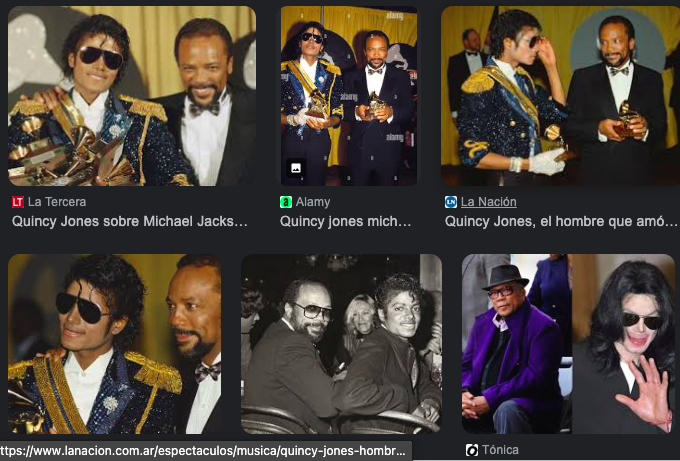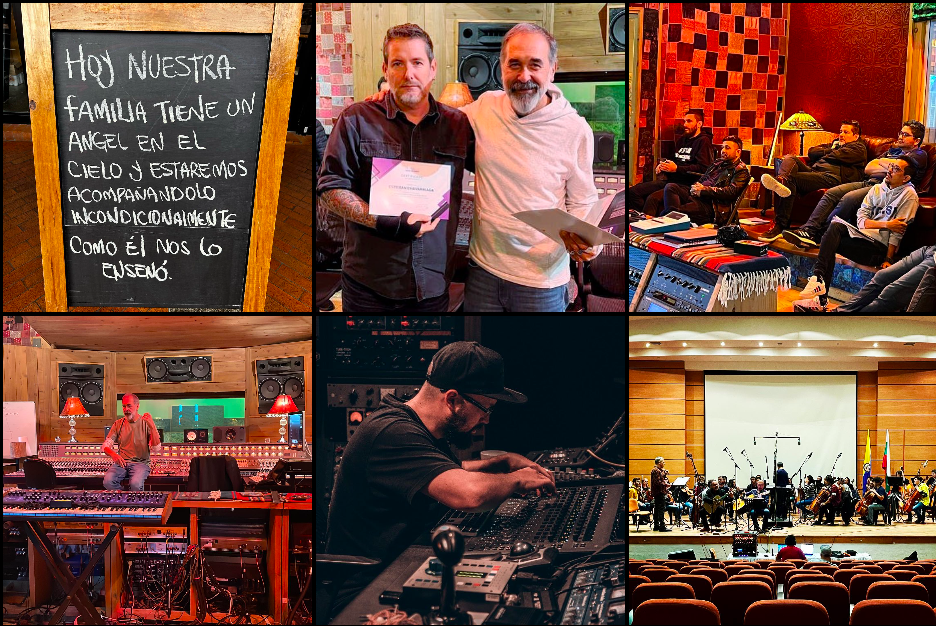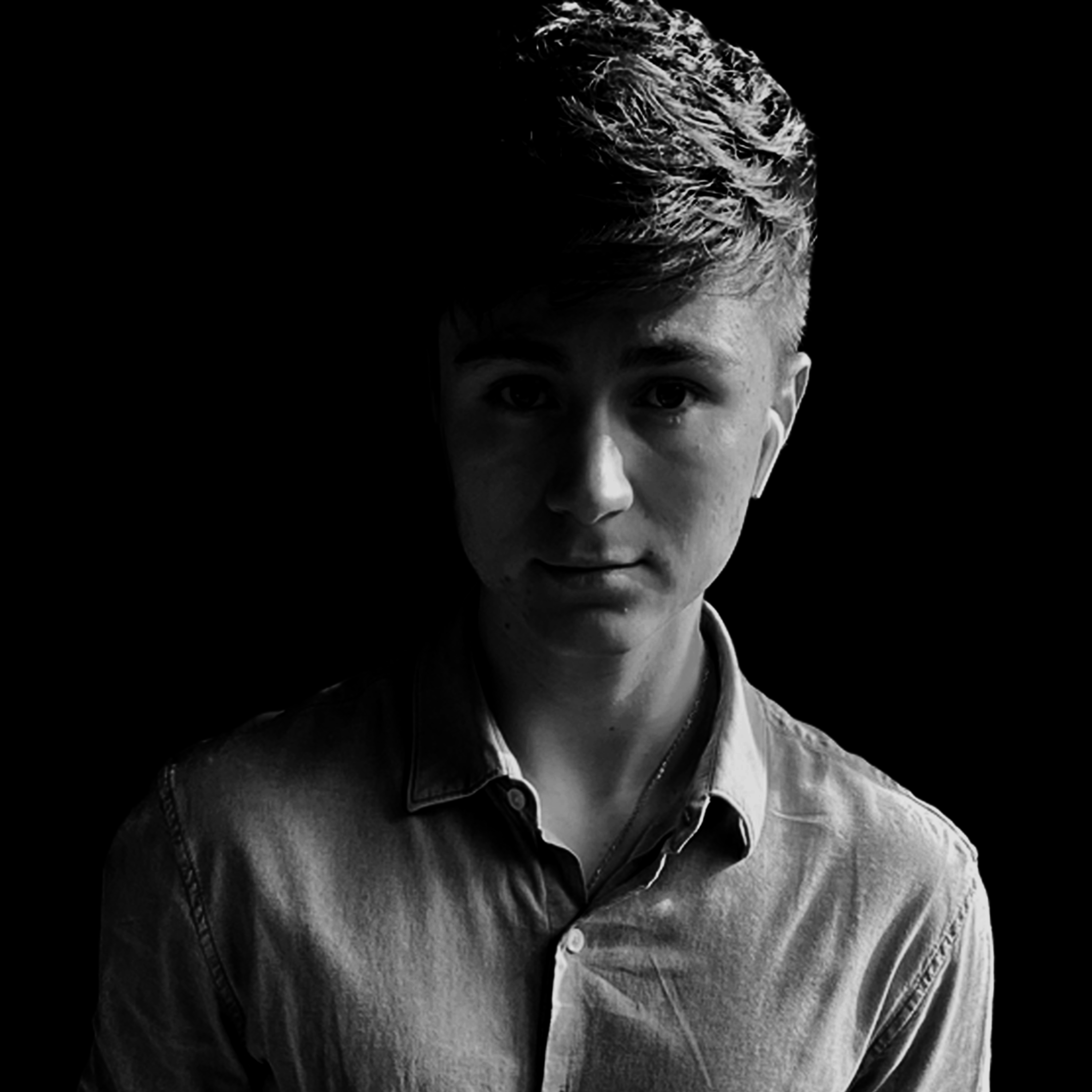By Lucas Waterbury Enriquez / @musicxlucas
Jose Juvinao is a Medellín-based bassist, musician, educator, music producer and freelancer who has collaborated with acclaimed artists such as Kany Garcia, Camilo, Becky G, J Balvin and Chocquibtown, among others. He has participated on the sound engineering teams of 3 Latin Grammy winning albums and has received a further sixteen nominations as sound engineer and/or musician.
But I had no idea of this amazing background when I met Juvinao 4 years ago at my local music school in Medellín.
To me he became my teacher and mentor, inspiring me to be the best musician I can be. He also introduced me to the world of music production, and encouraged me to learn this craft to enhance my career as a musician. Now that I attend Catalyst Institute for the Arts’ Creative Audio Production program in Berlin, I had the opportunity to interview him to get even more clarity on the career path I am taking and to get his words of wisdom on his experience as a freelance bassist, musician, and producer.
What I have always admired about Juvinao is that he is not only talented (genius level), he is also humble. No wonder, when I asked him if he could share with me his most important lesson as a bassist, musician, music producer and freelancer, he remarked: «Lucas, first and foremost, be a good person». He also noted that there are millions of music producers worldwide, but few understand that the craft is not just science/technology, but an art, and even fewer understand how important «humanity» is to the craft.
There are indeed millions of music producers out there and I wonder how many treat the craft in this way?
I decided to google how many music producers exist out there. I got anxious, competition is high. Some entries said jokingly that half of the world is composed of music producers. In fact, it is impossible to know how many music producers are out there for various reasons including the fact that many people call themselves music producers even if they have only learned the basics of beat making through youtube tutorials. Spotify alone receives over 60,000 new tracks every day (as of January 22, 2024), but for each of those tracks, what is certain is that there were many music producers behind.
But I ask myself, how many do it well? How many are highly technical and/or highly musical or both? Do they see the craft as art? And do they even care about being good people as part of the craft? What would it take to become this ideal professional?
Music production, a process that needs captains
For those of you who are new to the field, in a nutshell, music production is a process and it requires a captain of production who is able to manage the different parts of the craft and the different expectations and people involved. In this process, music is created, captured, manipulated, and preserved so that it can be distributed and enjoyed (Berklee.edu). In fact, music producers oversee the entire recording process. They shape the sound of a recording and often contribute with their creativity. It is therefore important to have at least some musical background in order to combine the technical aspects of the craft. Juvinao notes that his point of entry into producing other artists’ music is first and foremost his training in classical music and jazz: «As a bassist, I have recorded over 3,000 songs and produced many of them. It is this starting point that allows him to confidently contribute to the process of creating and producing his own music and music for others. He gives me an extra tip: «When you work for an artist, it is your responsibility to do all the research on that artist, to understand them fully, to «humbly» suggest ideas as and when needed, always with the goal of realizing their vision with excellence».
Jackson argues in The Music Producers Survival Guide that the ideal producer also knows his artists’ strengths and weaknesses, the market and the audience, how to coach performances and, if relevant, what the label wants (and how to get the best out of the artist even if it is not exactly what the label wants)». In essence, the producer is helping the artist to be the best version of themselves. This also applies to being a producer of your own music, as do the lessons below.


FUENTE:: https://www.instagram.com/jose_juvinao/ The picture above depicts Juvinao playing his bass and performing. The picture below depicts Camilo, Colombian artist.
The craft is highly technical, keep up with it!
Imagine going back in time to 1888. According to Jackson, pre-recorded records didn’t involve any of the sophisticated equipment we have today. Musicians gathered around a gramophone horn and played their music onto wax discs.

FUENTE: https://acortar.link/szlhqf / https://pixabay. Left picture: Man using gramophone horn. Right picture: modern music production equipment.
An early pioneer of music ‘production’, Fred Gaisberg, set up the first ‘recording’ studio (the London Gramophone Company, later HMV/EMI) in 1898 by instructing an opera singer to change his distance from the gramophone horn. Jackson also notes that later in the 1950s and 60s, a time of rock and roll, soul, R&B, funk, visionaries such as Phil Spector and Berry Gordy, to name but a few, were music recorders who oversaw the whole process (hence the first producers) from songwriting to hiring musicians to capturing the perfect performance in the studio. They became collaborators, working hand in hand with the artists (Quincy Jones ring a bell?). (The Music Producers Survival Guide).

FUENTE: La nacion.com: Quincy Delight Jones Jr. (born March 14, 1933) is an American record producer, songwriter, composer, arranger, and film and television producer. His best-known work includes producing an all-time best-selling album, Michael Jackson’s Thriller (1982), organizing the all-star charity recording “We Are the World” (1985), and producing the film The Color Purple (1985) and the television series The Fresh Prince of Bel-Air (1990–96). In 1993 he founded the magazine Vibe, which he sold in 2006.
Since the days of Phil Spector and Berry Gordy, recording and producing technology has continued to evolve rapidly. The 1970s saw the emergence of synthesizers and the introduction of the MIDI standard, paving the way for electronic music production. In the 1980s, digital audio recording technologies emerged, alongside advancements in sampling, MIDI sequencing, and digital effects processing. The 1990s witnessed the widespread adoption of computer-based recording and the rise of software-based DAWs, revolutionizing music production by making it more accessible and affordable. Plug-ins and virtual instruments further expanded the creative possibilities for producers, while the internet and digital distribution platforms transformed the music industry’s landscape.
Over the last 20 years, there have been rapid advancement in DAW capabilities, digital mixing console and cloud-based collaboration tools. These tools have allowed artists and producers to create and distribute music easily and efficiently. This ongoing technological evolution has democratized the music-making process, empowered a new generation of creators, and reshaped the way music is produced and distributed.
With all of these ongoing changes, music producers of today indeed have to have strong technical skills and have to keep up with the latest changes in software and recording technology.
Humanity in the art of music production
Deep emotions and stories permeate the process of composing and producing music. The final product is shared and distributed. The craft is emotionally rich. It involves deep sonic experiences created through music. This is indeed art in its deepest sense. Music is often a refuge for many people. Juvinao told me that during the pandemic he (like many other artists) had redefined himself to support others with his skills and to provide a space where he could support people with his services and his passion for music. He had set up his own home studio and was using it to its full potential. The pandemic actually spurred artists/producers like Juvinao to use the momentum to offer services to a wide range of musicians who were using the pandemic for music composition and development, but who needed «home» studios with the flexibility to offer a range of music production services. This has allowed Juvinao to continue to expand and build its own home studio, while growing its client base to over 600 artists in just one year!
For Juvinao, the human part of the craft also means being humble and having respect for other people. «Never lose sight of being respectful, humble and curious about who you are working with and collaborating with», he says. He goes on to say that if you’re producing music for someone and don’t understand the artist’s genre or vision, «just try harder! Understanding a client’s vision is crucial, realizing their desired outcome takes a lot out of you». He added that it was important to see the process as an opportunity, as you build a reputation, the more people trust you, the more you can bring your creativity and suggestions to the table. You end up making a better product,» he said. The process requires a lot of discipline and focus.
Humanity in music-making and production also refers to the need for relationships and collaboration. «Always strive to create a community,» added Juvinao.
Building my own studio? A shared collective studio?
I know that music production is also a business, and I’m thinking that if I go back home and continue to build my own studio (I started before I came to Berlin), what would it take to build a bigger studio (apart from a lot of money, which I still don’t have).
There is something about «old» style vintage music studios that I love. The ones where you can find analogue gear and state of the art technology, but still feel at home. When I was given Lego as a child, I never followed the instructions, I didn’t build the ships, castles, airplanes or spaceships that were supposed to be built, I always chose to build music studios. In fact, one day I mixed all the Star Wars Legos with the airplanes and castles Legos in a huge box to build a music city. This city had music art centers in imaginary cities where music was the most important thing in life. I still like that imaginary creation.

I think to myself, what if for my career I could reimagine a music studio of my own, offering regular recording services, but also a space for creativity and collaboration? In my personal life, it is crucial that I have a space where I can create alone, but also with my peers. What would it take to create a space, one step further than a regular studio, where music production truly combines art, science and humanity, in the words of Juvinao?
To visualize this, I turned to the talented owner and creator of La Luna Studio , Esteban Echeverria, also from Medellin, Colombia. Incidentally, Medellin is often recognized as the musical capital of the world because of its rich musical heritage, innovation, and culture. No wonder both Juvinao and Esteban come from this city.

FUENTE: https://www.instagram.com/lalunaestudio/ Screenshot of La Luna’s instagram depicting La Luna’s community, heart felt messages, and Esteban and staff members of La Luna.
Esteban created La Luna in 2013 (to honor his children ‘s names: Lucas y Juana). A marketing expert who learned the audio craft in several jobs, he set up the first studio with a friend, but this first endeavor didn’t work. He didn’t give up his dream. Surviving the pandemic and all, La Luna (previously known as El Alto) redefined itself and is one of Medellin’s most cherished recording studios and music production studios for artists.
I asked Esteban what makes La Luna so cozy for artists. La Luna is often used by ALCOLIRIS, Pipe Bueno, Silver Estragon, Karel Lizarraga, Yatra’s band, and Karol G’s band to rehearse before performances, as well as several famous reggaeton artists.

FUENTE: https://www.instagram.com/lalunaestudio/ Picture depicting La Luna’s events. Kiko Castro’s talk sold out. Last row center picture depicts me among music production peers and artists attending one of La Luna’s events.
“Studios such as La Luna will never stop being used because in the world of audio there’s always going to be music that will need the adequate space to record itself.” Pondering the future, he envisions a music industry shaped by a digital world but who will never stop looking for the essence of human expression. “Music may take various forms, but its heart will always beat with authenticity” he reflects.
A Studio for Audio Art and to Build Community
This sentiment strikes a chord within me, igniting a curiosity about how a studio like La Luna can thrive amidst the ever-evolving industry. Interestingly, similar to Juvinao, La Luna relies on personal connections rather than social media for promotion. While this approach may seem unconventional, Esteban’s focus on providing exceptional experiences and nurturing an inclusive community at La Luna resonates deeply with me.
The decision to establish La Luna amidst the tranquility of rural surroundings captivates me. It intends to be an ode to inspiration for musicians and a practical consideration for financial sustainability. Esteban’s sharp financial insight shines through; he benefits from reduced overhead costs compared to a bustling urban setting like Medellin. Moreover, he champions the notion that artists flourish amidst the embrace of nature, citing the lush tropical forest surrounding La Luna as an ideal space for musical exploration. Esteban’s innovative spirit is evident in his initiatives. He commissioned a local artist to breathe life into the studio’s logo with a vibrant mural on La Luna’s door. La Luna also offers intimate gatherings and coffee charlas to foster a sense of belonging within the community.
Merging Tradition and Innovation
La Luna embodies both vintage and innovation. With ninety percent of its clients embracing the warmth of analog equipment while the remaining ten percent opt for digital tools. Esteban emphasizes the importance of catering to diverse preferences and skill levels, ensuring that every artist feels empowered to bring their vision to life. This philosophy extends beyond equipment, reflecting Esteban’s commitment to creating a welcoming and supportive environment for all.
Witnessing this local studio thrive in my hometown is nothing short of inspiring. In 2022, when I recorded a song at La Luna, I happened to arrive early to the Studio. I was lucky to hear a band infusing the studio with their infectious energy, connecting on a deep level. Witnessing their passion alongside the producer’s guiding hand left an indelible mark on my soul.
This memory confirms a lesson and conclusion for today. Amidst a society fragmented by differences, music production serves as a unifying force, reminding us of our shared humanity and intrinsic desire to connect. Beyond creating, shaping and manipulating sounds, it’s a profound journey that resonates with the core of our existence, evoking our deepest emotions and connections.

Lucas Waterbury is a musician, songwriter and producer. Raised in Colombia and the United States, his music is inspired by the harmonic richness of jazz and R&B, and the many sounds that come out of Latin America. He is based in Berlin and Medellin.

Deja un comentario